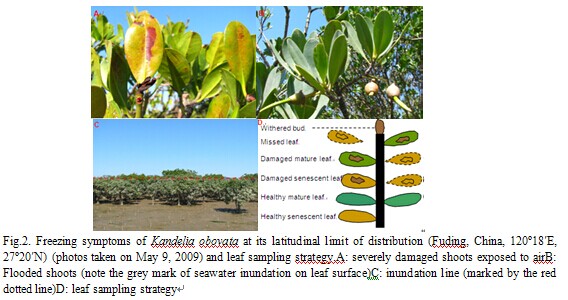Wang W. Q., You S. Y., Wang Y. B., Huang L., Wang M*.Plant and Soil, 2011. 342: 105-115.
The latitudinal distribution of mangrove species is limited mainly by low temperature. Leaf scorch and massive leaf fall are the predominant symptoms of frost damage. Nutrient resorption during leaf senescence is an important adaptation mechanism of mangroves. Abnormal defoliation disturbs nutrient resorption. We evaluated the effects of frost on nutrient loss of mangroves and the protective effects of warmer seawater inundation on reducing nutrient loss. On January 14, 2009, the most cold-tolerant mangroveKandeliaobovataat its naturally latitudinal limit (Fuding, China, 27°17΄N) was exposed to freezing temperature (-2.4 ºC) for four hours (minimum -2.8 ºC). The freezing air temperature occurred during flood tide, resulting that the flooded shoots were protected by warmer seawater. Frost caused 31.3% and 13.0% defoliation on the exposed shoots and the flooded shoots, respectively. Frost restricted nutrient resorption during leaf senescence.K. obovataresorbed 61% N and 42% P during normal leaf senescence, respectively. However, frost-damaged leaves only resorbed 13% N and 10% P during the course, respectively. Foliar N:P molar ratios were <31 , suggesting n limitation. tidal inundation can partially protect mangroves from frost damage. reduced nutrient resorption efficiency and massive leaf fall caused by frost add pressure to mangroves under nutrient limitation at their latitudinal limits.


